Evaluating Earthquake-Induced Damage in Hatay Following the 2023 Kahramanmaraş Earthquake Sequence: Tectonic, Geotechnical, and Structural Engineering Insights
Abstract
1. Introduction
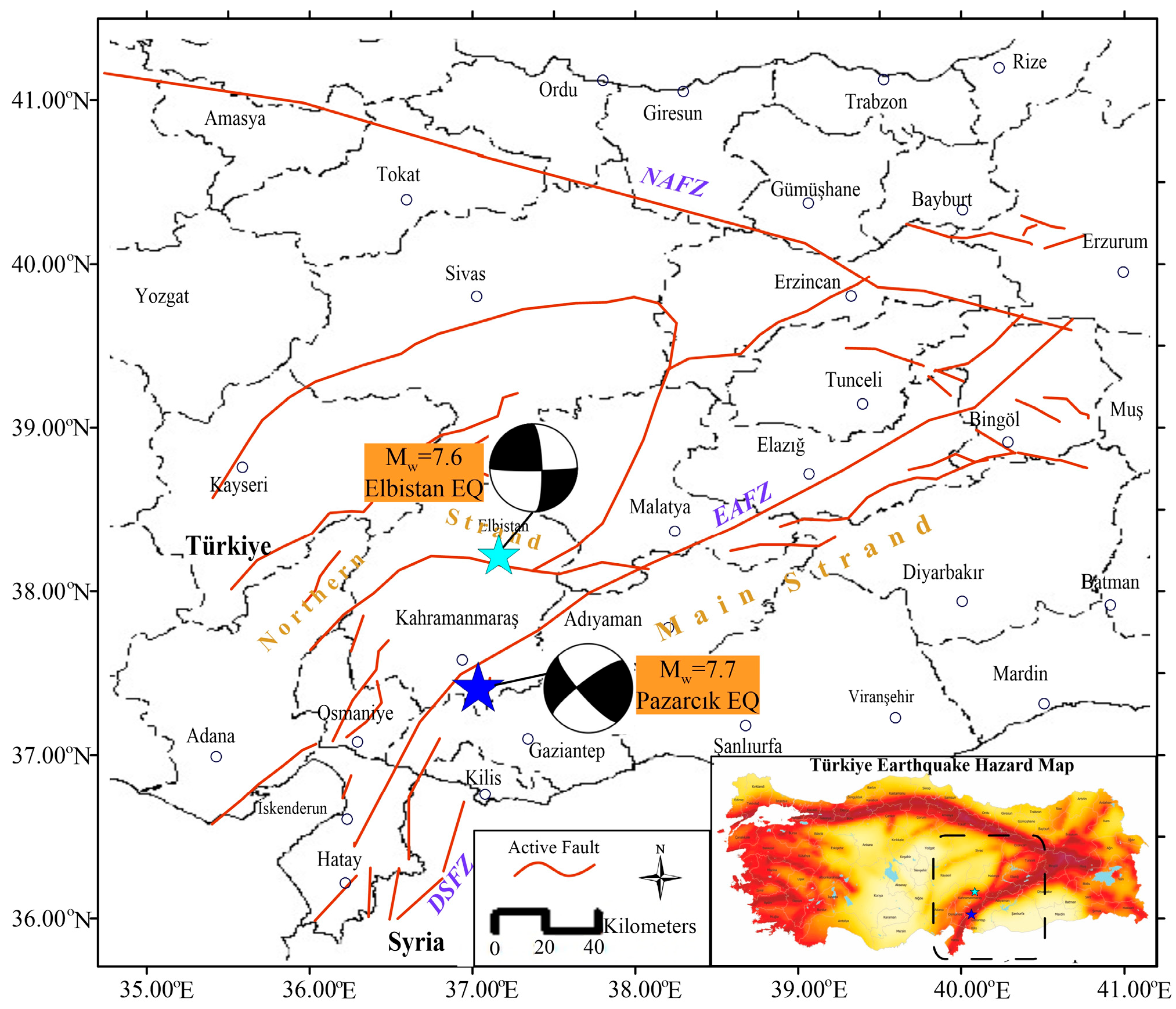
2. Tectonics and Seismicity of the Region
3. Geology of Hatay

4. Evaluation of Strong Ground Motion Data
4.1. General Characteristics of Kahramanmaras Earthquakes


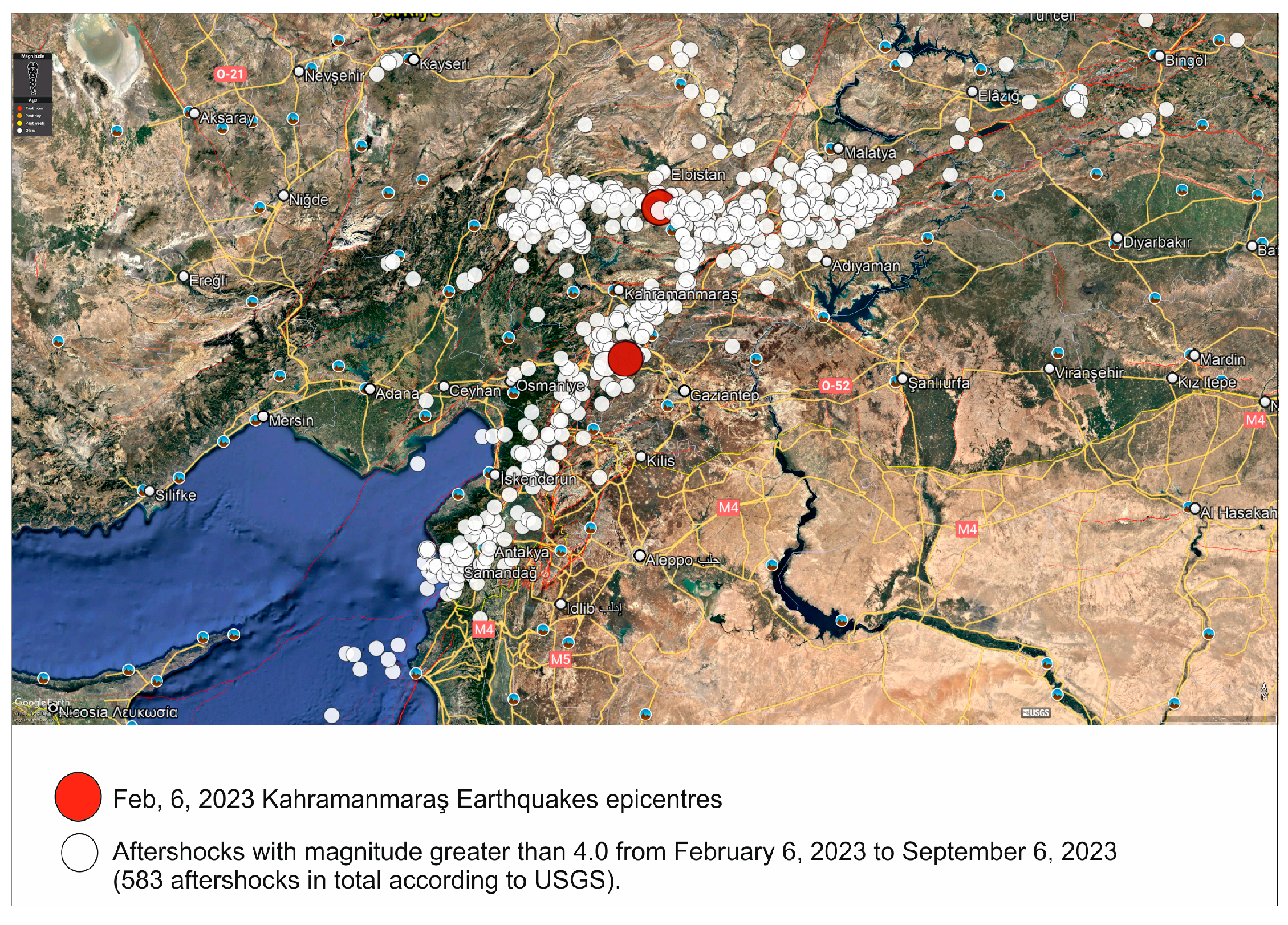
| Station | Measured Acceleration Values (g) | RJB (km) | Rrup (km) | Repi (km) | ||||||
|---|---|---|---|---|---|---|---|---|---|---|
| Code | Province | District | Latitude | Longitude | N-S | E-W | U-D | |||
| Nar | Kahramanmaras | Narlı | 37.3919 | 37.1574 | 0.692 | 0.638 | 0.229 | 0.00 | 7.47 | 15.35 |
| 4616 | Kahramanmaras | Türkoğlu | 36.83836 | 37.37547 | 0.622 | 0.437 | 0.395 | 4.03 | 22.42 | 20.54 |
| 2712 | Gaziantep | Nurdağı | 36.73283 | 37.184 | 0.567 | 0.604 | 0.320 | 2.74 | 11.58 | 29.79 |
| 4614 | Kahramanmaras | Pazarcik | 37.29775 | 37.48513 | 1.987 | 2.006 | 1.379 | 0.00 | 8.25 | 31.42 |
| 4621 | Kahramanmaras | Dulkadiroğlu | 37.59347 | 36.92909 | 0.376 | 0.229 | 0.678 | 28.49 | 36.32 | 35.42 |
| 2718 | Gaziantep | İslahiye | 36.6266 | 37.00777 | 0.667 | 0.643 | 0.604 | 0.00 | 2.10 | 48.30 |
| 3144 | Hatay | Hassa | 36.75691 | 36.485742 | 0.615 | 0.789 | 0.481 | 12.36 | 12.36 | 77.04 |
| 3142 | Hatay | Kırıkhan | 36.36612 | 36.49797 | 0.665 | 0.754 | 0.466 | 38.09 | 38.09 | 106.49 |
| 0201 | Adıyaman | Merkez | 38.26742 | 37.76121 | 0.383 | 0.282 | 0.206 | 45.76 | 48.06 | 120.12 |
| 3129 | Hatay | Defne | 36.1343 | 36.19117 | 1.378 | 1.222 | 0.731 | 75.71 | 75.71 | 146.39 |
| Station | Measured Acceleration Values (g) | RJB | Rrup | Repi | ||||||
|---|---|---|---|---|---|---|---|---|---|---|
| Code | Province | District | Latitude | Longitude | N-S | E-W | U-D | |||
| 4631 | Kahramanmaras | Nurhak | 37.966325 | 37.427653 | 0.324 | 0.400 | 0.559 | 11.60 | 19.69 | 21.43 |
| 4611 | Kahramanmaras | Çağlayancerit | 37.7472 | 37.28426 | 0.196 | 0.136 | 0.073 | 0.00 | 6.85 | 38.21 |
| 4612 | Kahramanmaras | Göksun | 38.02395 | 36.48187 | 0.640 | 0.531 | 0.439 | 62.18 | 62.18 | 66.68 |
| 0213 | Adıyaman | Tut | 37.79667 | 37.92957 | 0.123 | 0.129 | 0.072 | 55.16 | 61.35 | 68.73 |
| 3802 | Kayseri | Sarız | 38.47812 | 36.50359 | 0.197 | 0.222 | 0.122 | 58.12 | 58.12 | 77.41 |
| 4406 | Malatya | Akçadağ | 38.34388 | 37.97378 | 0.454 | 0.390 | 0.290 | 60.69 | 66.64 | 70.17 |
4.2. Evaluation of Strong Ground Motion Records Measured in Hatay
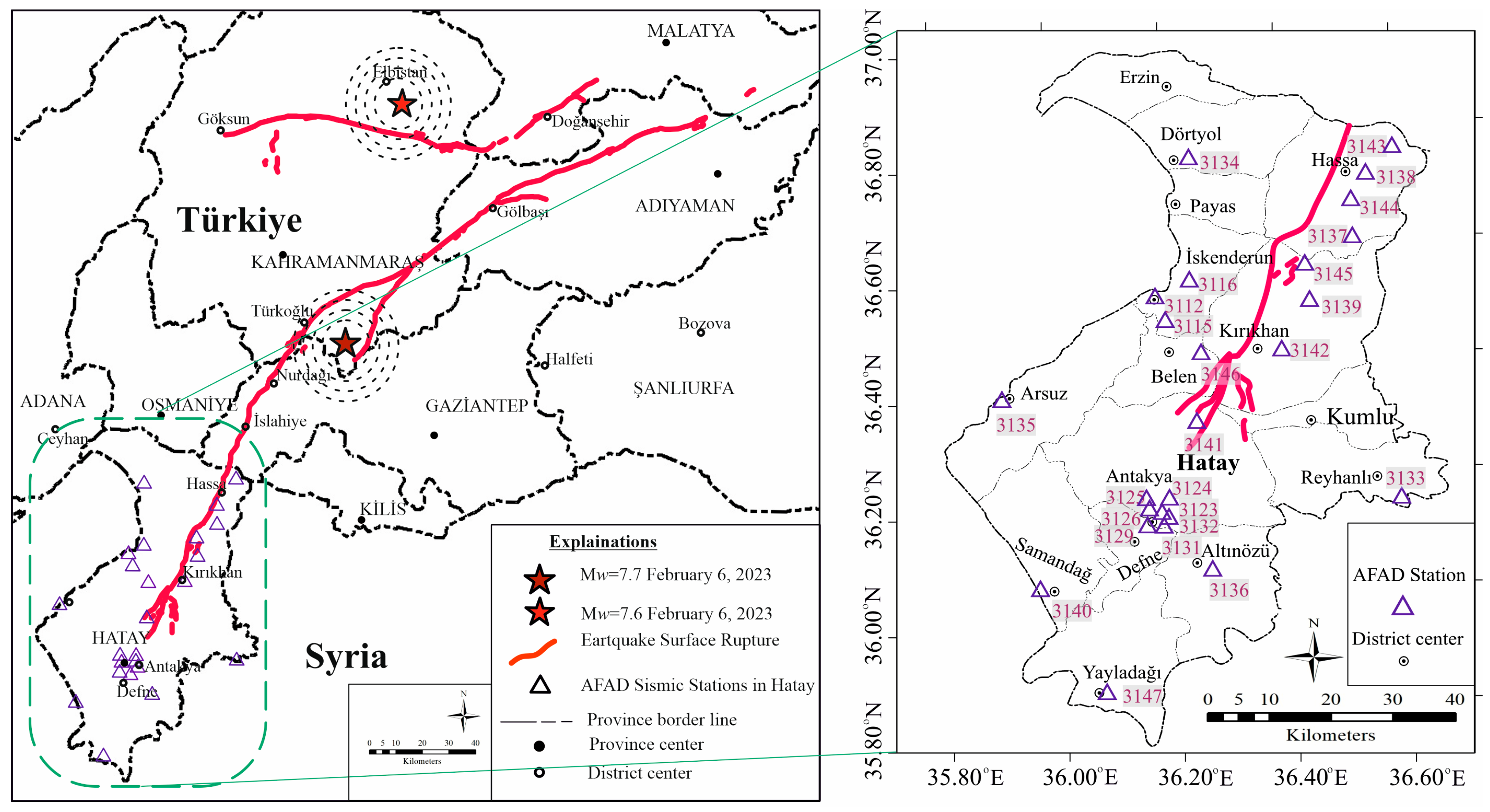
| Code | Longitude | Latitude | Province | District | PGA | PGV | PGD | RJB (km) | Rrup (km) | Repi (km) | |||||
|---|---|---|---|---|---|---|---|---|---|---|---|---|---|---|---|
| E-W | N-S | U-D | E-W | N-S | E-W | N-S | Vs (30) | ||||||||
| 3143 | 36.5571 | 36.8489 | Hatay | Hassa | 0.35 | 0.39 | 0.39 | 104.41 | 124.90 | 90.64 | 125.70 | 444 | 8.10 | 8.10 | 65.13 |
| 3144 | 36.4857 | 36.7569 | Hassa | 0.79 | 0.62 | 0.48 | 133.43 | 131.50 | 132.73 | 111.56 | 485 | 12.36 | 12.36 | 77.04 | |
| 3134 | 36.2049 | 36.8276 | Dörtyol | 0.20 | 0.25 | 0.12 | 39.55 | 39.14 | 66.35 | 41.35 | 374 | 14.24 | 16.71 | 90.29 | |
| 3137 | 36.4885 | 36.6929 | Hassa | 0.68 | 0.44 | 0.46 | 76.88 | 80.90 | 54.25 | 142.11 | 688 | 18.44 | 18.44 | 82.48 | |
| 3145 | 36.4064 | 36.6454 | Kırıkhan | 0.71 | 0.60 | 0.62 | 157.83 | 116.51 | 125.39 | 125.82 | 533 | 21.68 | 21.68 | 91.13 | |
| 3139 | 36.4144 | 36.5838 | Kırıkhan | 0.51 | 0.58 | 0.36 | 145.32 | 155.50 | 119.04 | 120.40 | 272 | 28.54 | 28.54 | 96.19 | |
| 3116 | 36.2066 | 36.6162 | İskenderun | 0.16 | 0.16 | 0.15 | 35.02 | 39.76 | 43.99 | 68.95 | 870 | 29.98 | 29.98 | 105.38 | |
| 3112 | 36.1477 | 36.5880 | İskenderun | 0.08 | 0.10 | 0.09 | 10.19 | 15.75 | 13.39 | 16.97 | 233 | 35.61 | 35.61 | 111.31 | |
| 3142 | 36.3661 | 36.4980 | Kırıkhan | 0.75 | 0.66 | 0.47 | 76.23 | 90.52 | 98.85 | 80.02 | 539 | 38.09 | 38.09 | 106.49 | |
| 3115 | 36.1646 | 36.5463 | Belen | 0.23 | 0.29 | 0.22 | 48.32 | 41.13 | 74.00 | 30.33 | 424 | 38.53 | 38.53 | 113.57 | |
| 3146 | 36.2270 | 36.4908 | Belen | 0.33 | 0.47 | 0.28 | 54.64 | 42.21 | 70.92 | 51.94 | None | 41.57 | 41.57 | 114.57 | |
| 3141 | 36.2197 | 36.3726 | Antakya | 0.85 | 1.01 | 0.68 | 123.99 | 80.61 | 107.39 | 60.97 | 338 | 54.20 | 54.20 | 125.42 | |
| 3135 | 35.8831 | 36.4089 | Arsuz | 1.34 | 0.76 | 0.59 | 65.47 | 50.22 | 48.42 | 57.44 | 460 | 66.18 | 66.18 | 142.15 | |
| 3133 | 36.5736 | 36.2432 | Reyhanlı | 0.15 | 0.23 | 0.09 | 23.38 | 29.19 | 33.29 | 20.34 | 377 | 68.21 | 68.21 | 123.47 | |
| 3124 | 36.1722 | 36.2387 | Antakya | 0.63 | 0.58 | 0.59 | 97.04 | 112.37 | 89.43 | 47.28 | 283 | 69.66 | 69.66 | 140.11 | |
| 3125 | 36.1326 | 36.2381 | Antakya | 1.09 | 0.79 | 1.08 | 102.68 | 74.67 | 94.94 | 66.02 | 448 | 70.82 | 70.82 | 142.15 | |
| 3126 | 36.1375 | 36.2202 | Antakya | 1.02 | 1.20 | 0.94 | 92.75 | 110.27 | 88.70 | 50.97 | 350 | 72.55 | 72.55 | 143.54 | |
| 3123 | 36.1597 | 36.2142 | Antakya | 0.59 | 0.66 | 0.86 | 98.75 | 186.86 | 92.90 | 63.68 | 470 | 72.58 | 72.58 | 143.00 | |
| 3132 | 36.1716 | 36.2067 | Antakya | 0.52 | 0.51 | 0.36 | 51.99 | 67.46 | 67.44 | 31.77 | 377 | 73.08 | 73.08 | 143.12 | |
| 3131 | 36.1633 | 36.1912 | Antakya | 0.36 | 0.36 | 0.15 | 44.93 | 48.05 | 26.20 | 52.26 | 567 | 74.95 | 74.95 | 144.98 | |
| 3129 | 36.1343 | 36.1912 | Defne | 1.22 | 1.38 | 0.73 | 75.90 | 171.35 | 76.62 | 51.36 | 447 | 75.71 | 75.71 | 146.39 | |
| 3136 | 36.2472 | 36.1159 | Altınözü | 0.39 | 0.53 | 0.22 | 76.89 | 51.86 | 54.25 | 35.01 | 344 | 81.47 | 81.47 | 148.38 | |
| 3140 | 35.9498 | 36.0816 | Samandağ | 0.22 | 0.20 | 0.18 | 79.11 | 63.37 | 84.02 | 48.21 | 210 | 93.14 | 93.14 | 165.82 | |
| 3147 | 36.0644 | 35.9024 | Yayladağı | 0.11 | 0.06 | 0.03 | 12.85 | 13.69 | 13.70 | 18.86 | None | 108.21 | 108.21 | 177.12 | |
5. Post-Earthquake Field Research
| District | Damage State | Damage Ratio | |||||||
|---|---|---|---|---|---|---|---|---|---|
| DS5 | DS4 | DS3 | DS2 | DS1 | DS0 | O2 | O1 | ||
| Altınözü | 637 | 855 | 3899 | 595 | 5806 | 8744 | 695 | 109 | 0.263 |
| Antakya | 4070 | 6318 | 17,829 | 3413 | 20,120 | 9821 | 1697 | 296 | 0.458 |
| Arsuz | 190 | 177 | 1694 | 791 | 9061 | 15,868 | 987 | 240 | 0.074 |
| Belen | 72 | 138 | 717 | 157 | 2661 | 6063 | 209 | 112 | 0.095 |
| Defne | 1018 | 983 | 7076 | 1757 | 9229 | 5231 | 601 | 49 | 0.359 |
| Dörtyol | 64 | 105 | 1489 | 636 | 8081 | 14,532 | 1150 | 19 | 0.067 |
| Erzin | 4 | 6 | 583 | 166 | 3427 | 8770 | 622 | 163 | 0.046 |
| Hassa | 558 | 1031 | 2557 | 310 | 4869 | 6005 | 584 | 199 | 0.270 |
| İskenderun | 348 | 468 | 3105 | 1128 | 18,693 | 13,138 | 1369 | 165 | 0.106 |
| Kırıkhan | 604 | 1921 | 5727 | 1128 | 10,683 | 7978 | 971 | 79 | 0.294 |
| Kumlu | 74 | 129 | 657 | 48 | 1040 | 2167 | 96 | 70 | 0.209 |
| Payas | 38 | 51 | 448 | 129 | 3183 | 4281 | 348 | 39 | 0.066 |
| Reyhanlı | 117 | 321 | 1546 | 364 | 5618 | 15,052 | 456 | 49 | 0.086 |
| Samandağ | 615 | 677 | 5276 | 1741 | 9397 | 8185 | 624 | 13 | 0.254 |
| Yayladağı | 129 | 206 | 1290 | 275 | 1834 | 8013 | 599 | 125 | 0.138 |
| Total | 8538 | 13,386 | 53,893 | 12,638 | 113,702 | 133,848 | 11,008 | 1727 | |
5.1. The Impact of Tectonic and Geological Properties of the Region on the Damage
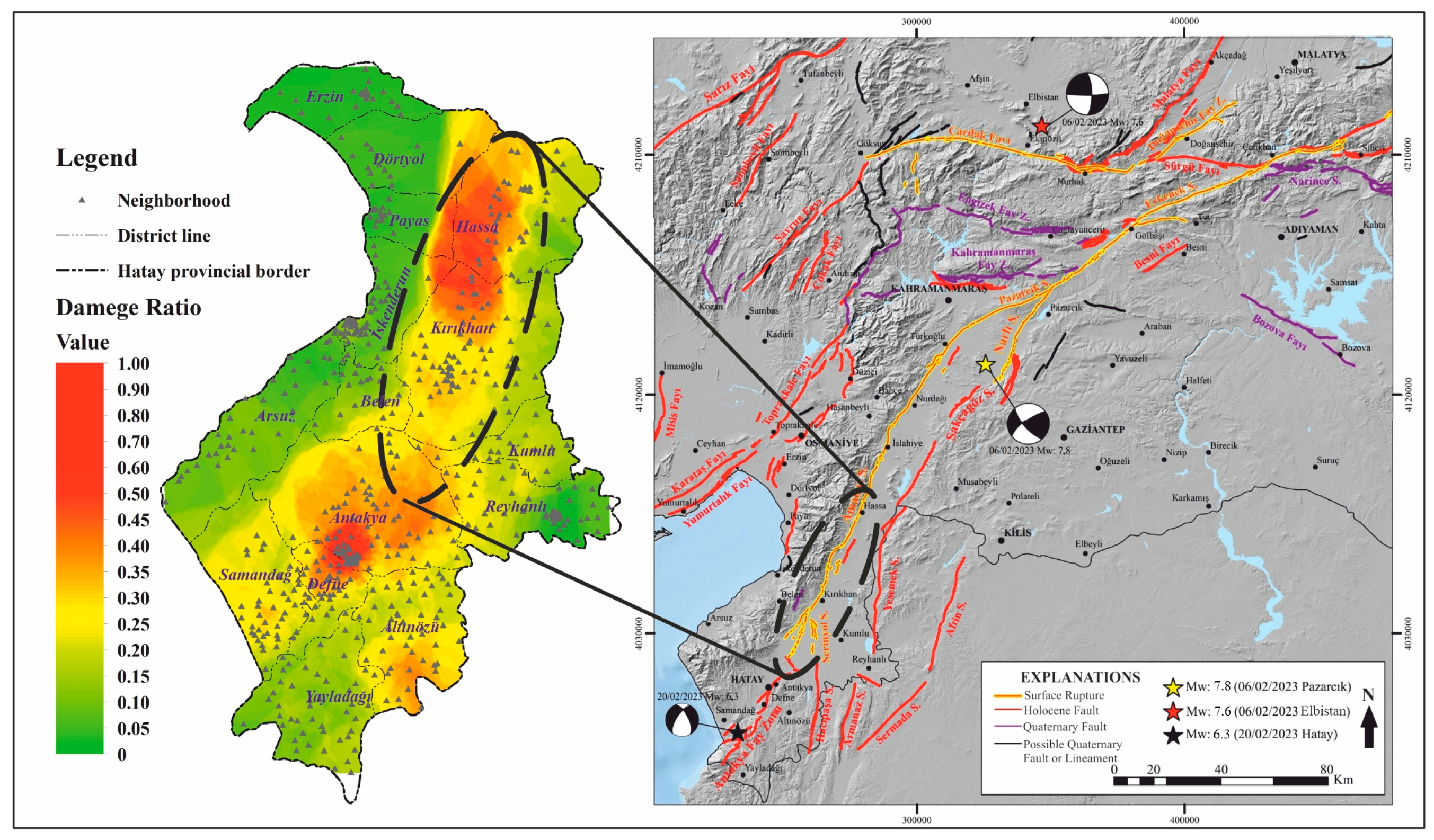

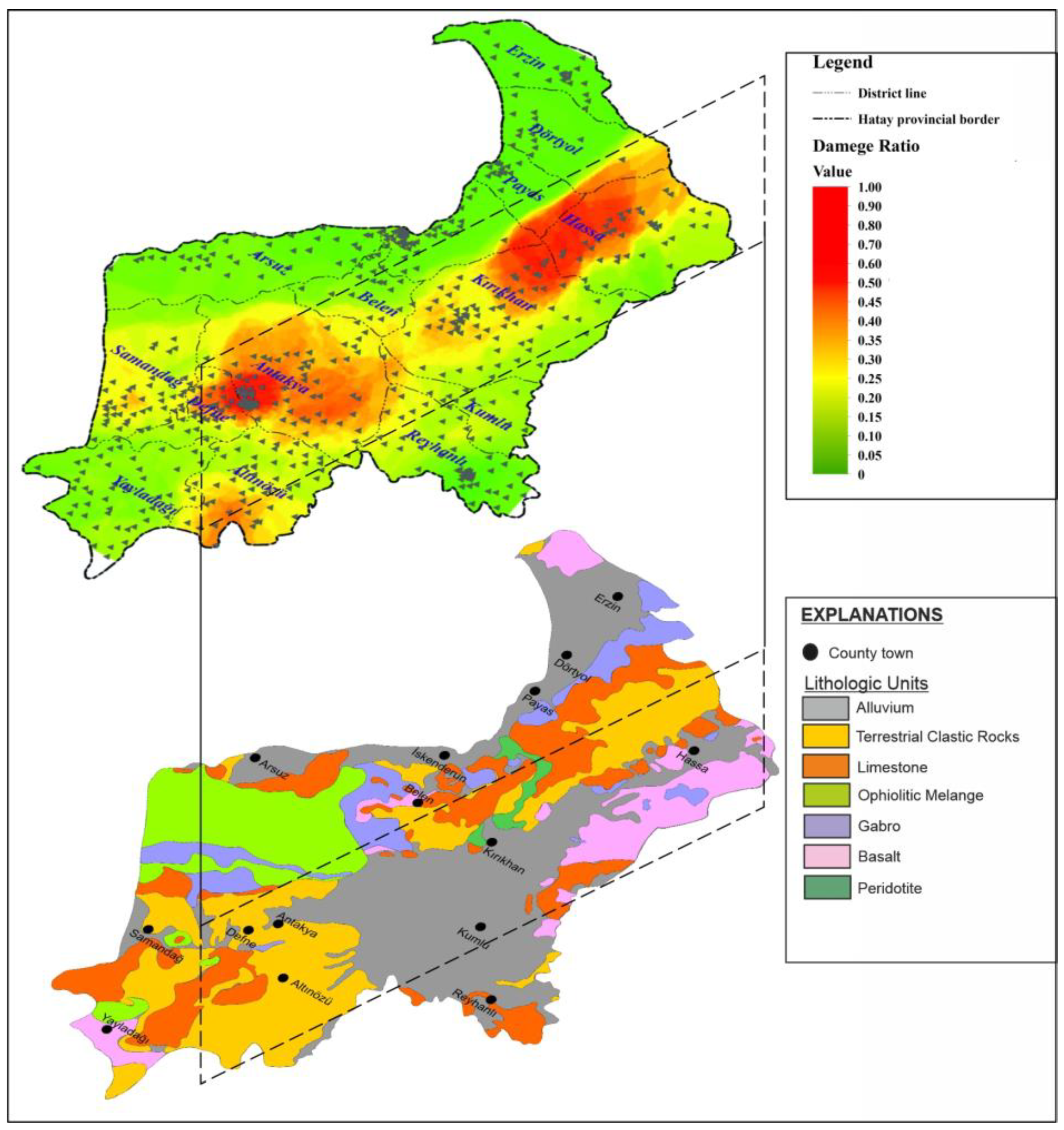
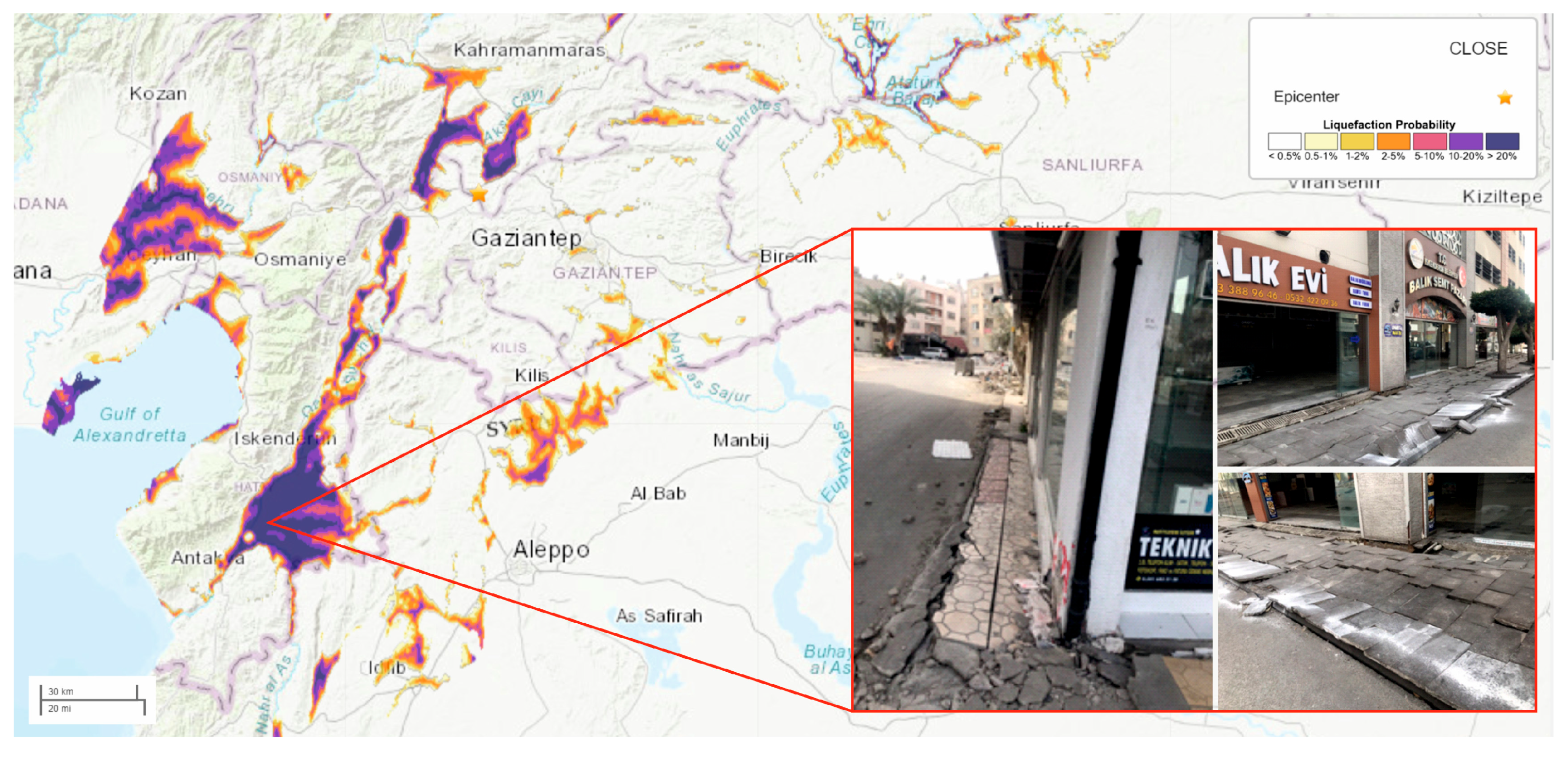
5.2. Seismic Performance of Structures
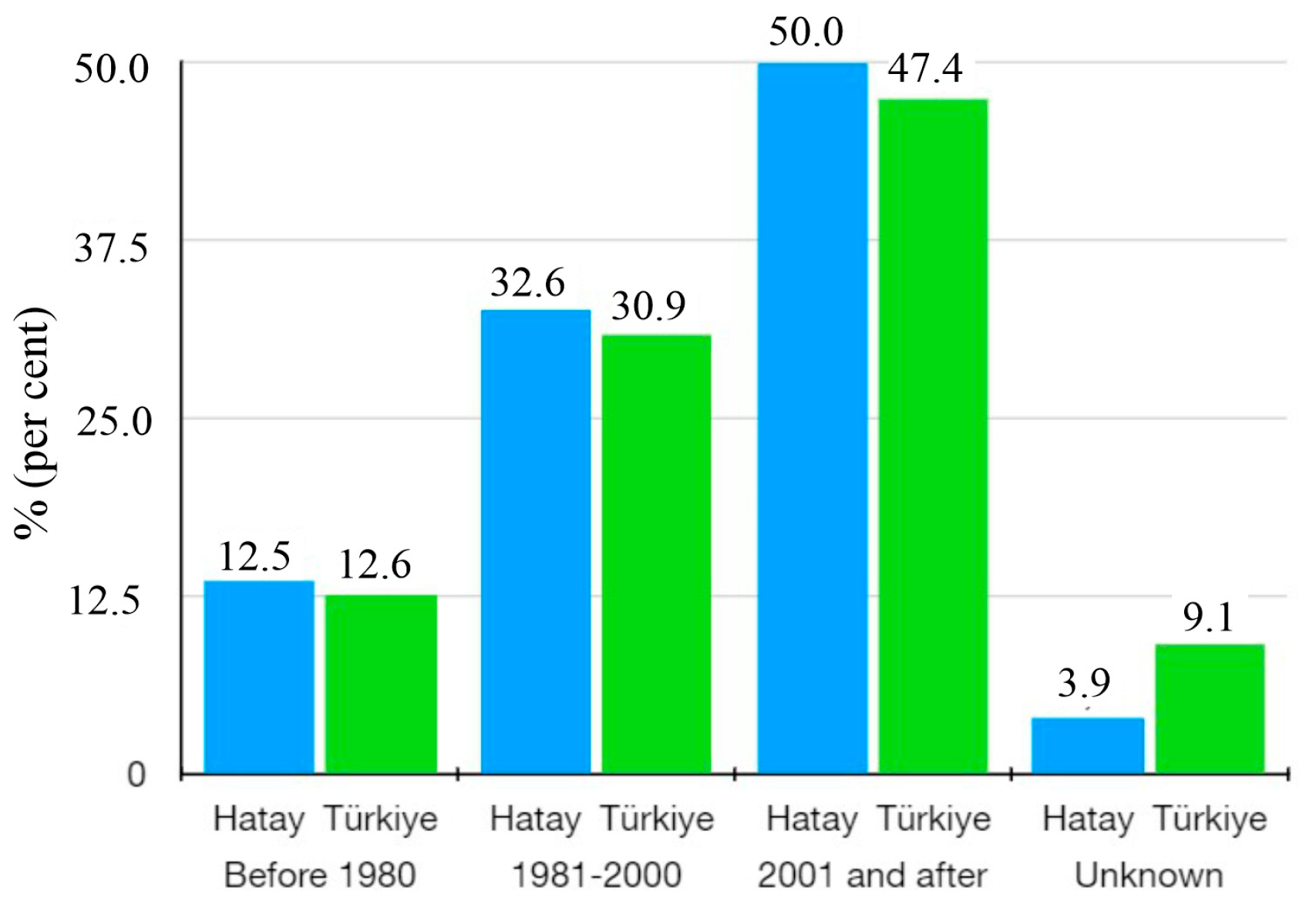
- Ribbed reinforcement ensures complete adherence between concrete material and the reinforcement. If the reinforcement is not ribbed, this adherence cannot be provided sufficiently, and this situation adversely affects the behavior of the structure against earthquake forces (Figure 22).
- Insufficient numbers of stirrups in columns and beam joints and not rotating the stirrup hooks 135° cause weakening of these joints (Figure 22). Numerous studies have emphasized that inadequate detailing and confinement in beam–column joints significantly compromise the seismic performance of reinforced concrete structures [105,106].
- Exposure of reinforcements to corrosion significantly reduces the strength and stiffness of the structural element. In reinforced concrete structures, it was observed that the corrosion effect reached serious dimensions (Figure 22).
- In multi-story buildings, the lower floors are generally used for commercial purposes. These floors are designed higher than other floors and have fewer infill walls. This situation creates a sudden decrease in the stiffness of the building system at ground-floor level and causes the formation of soft floors (Figure 23).
- A common feature observed in the damaged buildings is that many exhibit poor workmanship and wrong applications (Figure 24). It is possible to prevent this with good inspection.
6. Discussion
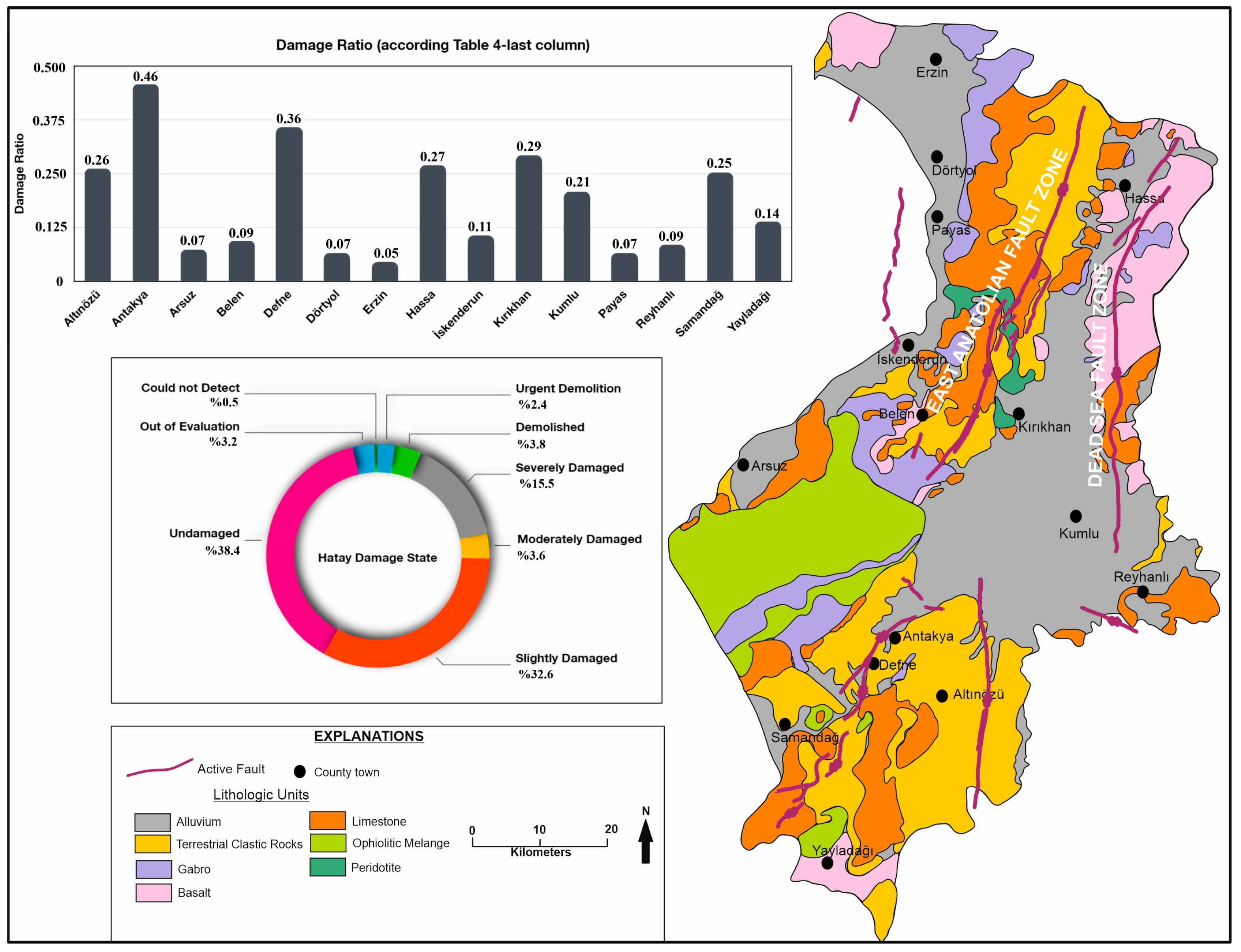
6.1. Conclusions and Recommendations
- The simultaneous occurrence of two high-magnitude earthquakes (Mw 7.7 and Mw 7.6) with closely located epicenters significantly amplified the seismic impact.
- The surface rupture of the first event extended nearly to the center of Hatay, intensifying structural damage.
- Hatay’s proximity to the East Anatolian Fault Zone and the Dead Sea Fault Zone contributed to widespread destruction.
- Districts aligned along the northeast–southwest axis (e.g., Hassa, Kırıkhan, Antakya, and Defne) exhibited the highest damage ratios due to both fault proximity and the prevalence of loose alluvial and clastic soils.
- The Amik Plain’s thick alluvial deposits facilitated seismic wave propagation, resulting in amplified ground motion and extended impact zones.
- Ground motion records revealed significant exceedances of design-level accelerations and velocities, indicating that current seismic hazard maps may underestimate actual seismic demand.
- The liquefaction potential and aging building stock further exacerbated structural vulnerabilities.
- Common failure mechanisms included soft-story collapses, inadequate reinforcement detailing, and poor construction practices.
- Historical and masonry structures suffered extensive damage due to lack of seismic design provisions and material deficiencies.
6.2. Recommendations
- Revise the Turkish Earthquake Hazard Map to reflect observed ground motion exceedances and updated seismic risk assessments.
- Implement stricter urban planning policies that consider fault proximity and soil characteristics, including liquefaction susceptibility.
- Promote site-specific geotechnical investigations and foundation design tailored to local lithology and groundwater conditions.
- Enforce the use of corrosion-resistant materials and adequate concrete cover in new constructions.
- Ensure full compliance with modern seismic codes (e.g., TBEC-2018) in both design and construction phases.
- Conduct rapid seismic performance evaluations of existing building stock and prioritize retrofitting or reconstruction of vulnerable structures.
- Establish mandatory training programs for construction workers and site supervisors to improve workmanship and reduce implementation errors.
Funding
Data Availability Statement
Conflicts of Interest
References
- DEMA. Earthquake Department of the Disaster and Emergency Management Presidency; DEMA: Ankara, Turkey, 2023. Available online: http://www.afad.gov.tr (accessed on 1 May 2023).
- Emre, Ö.; Duman, T.Y.; Olgun, Ş. 1:250.000 Scale Active Fault Map Series of Turkey, Antakya (NJ 37-13) Quadrangle; Serial Number: 39; General Directorate of Mineral Research and Exploration: Ankara, Turkey, 2012.
- World Bank. Earthquake Damage in Türkiye Estimated to Exceed $34 Billion: World Bank Disaster Assessment Report. 2023. Available online: https://www.worldbank.org/en/news/press-release/2023/02/27/earthquake-damage-in-turkiye-estimated-to-exceed-34-billion-world-bank-disaster-assessment-report (accessed on 1 July 2025).
- Ural, A.; Doğangün, A.; Sezen, H.; Angın, Z. Seismic performance of masonry buildings during the 2007 Bala, Turkey earthquakes. Nat. Hazards 2012, 60, 1013–1026. [Google Scholar] [CrossRef]
- Adanur, S. Performance of masonry buildings during the 20 and 27 December 2007 Bala (Ankara) earthquakes in Turkey. Nat. Hazards Earth Syst. Sci. 2010, 10, 2547–2556. [Google Scholar] [CrossRef]
- Akkar, S.; Aldemir, A.; Askan, A.; Bakir, S.; Canbay, E.; Demirel, I.O.; Erberik, M. 8 March 2010 Elazığ-Kovancılar (Turkey) Earthquake: Observations on ground motions and building damage. Seismol. Res. Lett. 2011, 82, 42–58. [Google Scholar] [CrossRef]
- Celep, Z.; Erken, A.; Taskin, B.; Ilki, A. Failures of masonry and concrete buildings during the March 8, 2010 Kovancılar and Palu (Elazığ) Earthquakes in Turkey. Eng. Fail. Anal. 2011, 18, 868–889. [Google Scholar] [CrossRef]
- Tapan, M.; Comert, M.; Demir, C.; Sayan, Y.; Orakcal, K.; Ilki, A. Failures of structures during the October 23, 2011 Tabanli (Van) and November 9, 2011 Edremit (Van) earthquakes in Turkey. Eng. Fail. Anal. 2013, 34, 606–628. [Google Scholar] [CrossRef]
- Yazgan, U.; Oyguç, R.; Ertaç Ergüven, M.; Celep, Z. Seismic performance of buildings during 2011 Van earthquakes and rebuilding efforts. J. Earthq. Eng. Eng. Vib. 2016, 15, 591–606. [Google Scholar] [CrossRef]
- Çelebi, E.; Aktas, M.; Çaǧlar, N.; Özocak, A.; Kutanis, M.; Mert, N.; Özcan, Z. October 23, 2011 Turkey/Van-Ercis earthquake: Structural damages in the residential buildings. Nat. Hazards 2013, 65, 2287–2310. [Google Scholar] [CrossRef]
- Yön, B.; Onat, O.; Öncü, M.E. Earthquake Damage to Nonstructural Elements of Reinforced Concrete Buildings during 2011 Van Seismic Sequence. J. Perform. Constr. Facil. 2019, 33, 04019075. [Google Scholar] [CrossRef]
- Oyguc, R.; Oyguc, E. 2011 Van Earthquakes: Lessons from Damaged Masonry Structures. J. Perform. Constr. Facil. 2017, 31, 04017062. [Google Scholar] [CrossRef]
- Bayraktar, A.; Altunişik, A.C.; Pehlivan, M. Performance and damages of reinforced concrete buildings during the October 23 and November 9, 2011 Van, Turkey, earthquakes. Soil Dyn. Earthq. Eng. 2013, 53, 49–72. [Google Scholar] [CrossRef]
- Taskin, B.; Sezen, A.; Tugsal, U.M.; Erken, A. The aftermath of 2011 Van earthquakes: Evaluation of strong motion, geotechnical and structural issues. Bull. Earthq. Eng. 2013, 11, 285–312. [Google Scholar] [CrossRef]
- Atmaca, B.; Demir, S.; Günaydin, M.; Altunişik, A.C.; Hüsem, M.; Ateş, Ş.; Adanur, S.; Angin, Z. Field Investigation on the Performance of Mosques and Minarets during the Elazig-Sivrice Earthquake. J. Perform. Constr. Facil. 2020, 34, 04020120. [Google Scholar] [CrossRef]
- Caglar, N.; Vural, I.; Kirtel, O.; Saribiyik, A.; Sumer, Y. Structural damages observed in buildings after the January 24, 2020 Elazığ-Sivrice earthquake in Turkiye. Case Stud. Constr. Mater. 2023, 18, e01886. [Google Scholar] [CrossRef]
- Dogan, G.; Ecemis, A.S.; Korkmaz, S.Z.; Arslan, M.H.; Korkmaz, H.H. Buildings Damages after Elazığ, Turkey Earthquake on January 24, 2020. Nat. Hazards 2021, 109, 161–200. [Google Scholar] [CrossRef]
- Dedeoğlu, İ.Ö.; Yetkin, M.; Calayır, Y. 24 January 2020 Sivrice-Elazığ Earthquake: Assessment of Seismic Characteristics of Earthquake, Earthquake Territory and Structural Performance of Reinforced Concrete Structures. Sak. Univ. J. Sci. 2022, 26, 1892–1907. [Google Scholar] [CrossRef]
- Yetkin, M.; Dedeoğlu, İ.Ö.; Calayır, Y. 24 Ocak 2020 Sivrice Depremi Sonrasında Elazığ İlinde Bulunan Minarelerde Meydana Gelen Hasarların Araştırılması ve Değerlendirilmesi. Fırat Üniversitesi Mühendislik Bilim. Derg. 2021, 33, 379–389. [Google Scholar] [CrossRef]
- Yurdakul, Ö.; Duran, B.; Tunaboyu, O.; Avşar, Ö. Field reconnaissance on seismic performance of RC buildings after the January 24, 2020 Elazığ-Sivrice earthquake. Nat. Hazards 2021, 105, 859–887. [Google Scholar] [CrossRef]
- Onat, O.; Yön, B.; Öncü, M.E.; Varolgüneş, S.; Karaşin, A.; Cemalgil, S. Field reconnaissance and structural assessment of the October 30, 2020, Samos, Aegean Sea earthquake: An example of severe damage due to the basin effect. Nat. Hazards 2022, 112, 75–117. [Google Scholar] [CrossRef]
- Yakut, A.; Sucuoğlu, H.; Binici, B.; Canbay, E.; Donmez, C.; İlki, A.; Caner, A. Performance of structures in İzmir after the Samos Island earthquake. Bull. Earthq. Eng. 2022, 20, 7793–7818. [Google Scholar] [CrossRef]
- Yön, B.; Onat, O.; Öncü, M.E.; Karaşın, A. Failures of masonry dwelling triggered by East Anatolian Fault earthquakes in Turkey. Soil Dyn. Earthq. Eng. 2020, 133, 106126. [Google Scholar] [CrossRef]
- Indirli, M.; Kouris, L.A.S.; Formisano, A.; Borg, R.P.; Mazzolani, F.M. Seismic damage assessment of unreinforced masonry structures after the Abruzzo 2009 earthquake: The case study of the historical centers of L’Aquila and Castelvecchio Subequo. Int. J. Archit. Herit. 2013, 7, 536–578. [Google Scholar] [CrossRef]
- Brandonisio, G.; Lucibello, G.; Mele, E.; Luca, A.D. Damage and performance evaluation of masonry churches in the 2009 L’Aquila earthquake. Eng. Fail. Anal. 2013, 34, 693–714. [Google Scholar] [CrossRef]
- Sorrentino, L.; Liberatore, L.; Liberatore, D.; Masiani, R. The behaviour of vernacular buildings in the 2012 Emilia earthquakes. Bull. Earthq. Eng. 2014, 12, 2367–2382. [Google Scholar] [CrossRef]
- Sorrentino, L.; Cattari, S.; da Porto, F.; Magenes, G.; Penna, A. Seismic behaviour of ordinary masonry buildings during the 2016 central Italy earthquakes. Bull. Earthq. Eng. 2019, 17, 5583–5607. [Google Scholar] [CrossRef]
- Penna, A.; Calderini, C.; Sorrentino, L.; Carocci, C.F.; Cescatti, E.; Sisti, R.; Borri, A. Damage to churches in the 2016 central Italy earthquakes. Bull. Earthq. Eng. 2019, 17, 5763–5790. [Google Scholar] [CrossRef]
- Gautam, D.; Chaulagain, H. Structural performance and associated lessons to be learned from world earthquakes in Nepal after 25 April 2015 (Mw 7.8) Gorkha earthquake. Eng. Fail. Anal. 2016, 68, 222–243. [Google Scholar] [CrossRef]
- Dutta, S.C.; Nayak, S.; Acharjee, G.; Panda, S.K.; Das, P.K. Gorkha (Nepal) earthquake of April 25, 2015: Actual damage, retrofitting measures and prediction by RVS for a few typical structures. Soil Dyn. Earthq. Eng. 2016, 89, 171–184. [Google Scholar] [CrossRef]
- Ismail, N.; Khattak, N. Observed failure modes of unreinforced masonry buildings during the 2015 Hindu Kush earthquake. Earthq. Eng. Eng. Vib. 2019, 18, 301–314. [Google Scholar] [CrossRef]
- Halder, L.; Chandra Dutta, S.; Sharma, R.P.; Bhattacharya, S. Lessons learnt from post-earthquake damage study of Northeast India and Nepal during last ten years: 2021 Assam earthquake, 2020 Mizoram earthquake, 2017 Ambasa earthquake, 2016 Manipur earthquake, 2015 Nepal earthquake, and 2011 Sikkim earthquake. Soil Dyn. Earthq. Eng. 2021, 151, 106990. [Google Scholar] [CrossRef]
- Göçer, C. Structural evaluation of masonry building damages during the April 24, 2014 Gökçeada earthquake in the Aegean Sea. Bull. Earthq. Eng. 2020, 18, 3459–3483. [Google Scholar] [CrossRef]
- Avcil, F.; Işık, E.; İzol, R.; Büyüksaraç, A.; Arkan, E.; Arslan, M.H.; Aksoylu, C.; Eyisüren, O.; Harirchian, E. Effects of the February 6, 2023, Kahramanmaras earthquake on structures in Kahramanmaras city. Nat. Hazards 2024, 120, 2953–2991. [Google Scholar] [CrossRef]
- Işık, E.; Avcil, F.; İzol, R.; Büyüksaraç, A.; Bilgin, H.; Harirchian, E.; Arkan, E. Field reconnaissance and earthquake vulnerability of the rc buildings in Adıyaman during 2023 Türkiye earthquakes. Appl. Sci. 2024, 14, 2860. [Google Scholar] [CrossRef]
- Işık, E. Structural failures of adobe buildings during the February 2023 Kahramanmaraş (Türkiye) earthquakes. Appl. Sci. 2023, 13, 8937. [Google Scholar] [CrossRef]
- Özturk, M.; Arslan, M.H.; Dogan, G.; Ecemis, A.S.; Arslan, H.D. School buildings performance in 7.7 Mw and 7.6 Mw catastrophic earthquakes in southeast of Turkey. J. Build. Eng. 2023, 79, 107810. [Google Scholar] [CrossRef]
- Özturk, M.; Arslan, M.H.; Korkmaz, H.H. Effect on RC buildings of 6 February 2023 Turkey earthquake doublets and new doctrines for seismic design. Eng. Fail. Anal. 2023, 153, 107521. [Google Scholar] [CrossRef]
- Mercimek, Ö. Seismic failure modes of masonry structures exposed to Kahramanmaras earthquakes (Mw 7.7 and 7.6) on February 6, 2023. Eng. Fail. Anal. 2023, 151, 107422. [Google Scholar] [CrossRef]
- Kocaman, İ. The effect of the Kahramanmaras earthquakes (Mw 7.7 and Mw 7.6) on historical masonry mosques and minarets. Eng. Fail. Anal. 2023, 149, 107225. [Google Scholar] [CrossRef]
- Erkek, H.; Yetkin, M. Assessment of the performance of a historic minaret during the Kahramanmaras earthquakes (Mw 7.7 and Mw 7.6). Structures 2023, 58, 105620. [Google Scholar] [CrossRef]
- Altunsu, E.; Güneş, O.; Öztürk, S.; Sorosh, S.; Sarı, A.; Beeson, S.T. Investigating the structural damage in Hatay province after Kahramanmaras-Turkiye earthquake sequences. Eng. Fail. Anal. 2024, 157, 107857. [Google Scholar] [CrossRef]
- Kazaz, İ.; Bilge, İ.H.; Gürbüz, M. Near-fault ground motion characteristics and its effects on a collapsed reinforced concrete structure in Hatay during the February 6, 2023 Mw7.8 Kahramanmaras earthquake. Eng. Struct. 2024, 298, 117067. [Google Scholar] [CrossRef]
- Kahya, V.; Genç, A.F.; Sunca, F.; Roudane, B.; Altunişik, A.C.; Yilmaz, S.; Günaydin, M.; Dok, G.; Kirtel, O.; Demir, A.; et al. Evaluation of earthquake-related damages on masonry structures due to the 6 February 2023 Kahramanmaras-Turkiye earthquakes: A case study for Hatay Governorship Building. Eng. Fail. Anal. 2024, 156, 107855. [Google Scholar] [CrossRef]
- Vuran, E.; Serhatoğlu, C.; Timurağaoğlu, M.; Smyrou, E.; Bal, I.E.; Livaoğlu, R. Damage observations of RC buildings from 2023 Kahramanmaras earthquake sequence and discussion on the seismic code regulations. Bull. Earthq. Eng. 2024, 23, 1153–1182. [Google Scholar] [CrossRef]
- Ivanov, M.L.; Chow, W.K. Structural damage observed in reinforced concrete buildings in Adiyaman during the 2023 Turkiye Kahramanmaras Earthquakes. Structures 2023, 58, 105578. [Google Scholar] [CrossRef]
- Özkaynak, M.I.; Cetin, K.O. The performance of Karasu Bridge following the February 6, 2023 Kahramanmaras-Turkiye earthquake sequence. Eng. Geol. 2024, 335, 107512. [Google Scholar] [CrossRef]
- Lashgari, A.; Soghrat, M.R.; Jafarian, Y.; Zafarani, H. The 2023 Turkey–Syria Earthquake Sequence: Ground-Motion and Local Site-Effect Analyses for Kahramanmaras City. Int. J. Civ. Eng. 2024, 22, 877–899. [Google Scholar] [CrossRef]
- Nemutlu, Ö.F. Loss analyses associated with the secondary effect in earthquake: A case study of Kahramanmaras earthquake sequences. Earthq. Struct. 2025, 28, 137. [Google Scholar] [CrossRef]
- Yetkın, M.; Dedeoğlu, I.Ö.; Tunç, G. February 6, 2023, Kahramanmaraş twin earthquakes: Evaluation of ground motions and seismic performance of buildings for Elazığ, southeast of Türkiye. Soil Dyn. Earthq. Eng. 2024, 181, 108678. [Google Scholar] [CrossRef]
- Dedeoglu, I.O.; Yetkin, M.; Tunc, G.; Ozbulut, O.E. Evaluating earthquake-induced damage in Dogansehir, Malatya after 2023 Kahramanmaras earthquake sequence: Geotechnical and structural perspectives. J. Build. Eng. 2025, 104, 112266. [Google Scholar] [CrossRef]
- Bozkurt, E. Neotectonics of Turkey–A synthesis. Geodin. Açta 2001, 14, 3–30. [Google Scholar] [CrossRef]
- Allen, M.; Jackson, J.; Walker, R. Late Cenozoic reorganisation of the Arabia-Eurasia collision and the comparison of short-term and long-term deformation rates. Tectonics 2004, 23. [Google Scholar] [CrossRef]
- Bayrak, E.; Yılmaz, Ş.; Softa, M.; Türker, T.; Bayrak, Y. Earthquake hazard analysis for East Anatolian fault zone, Turkey. Nat. Hazards 2015, 76, 1063–1077. [Google Scholar] [CrossRef]
- McKenzie, D. Active tectonics of the Mediterranean region. Geophys. J. Int. 1972, 30, 109–185. [Google Scholar] [CrossRef]
- DeMets, C.; Gordon, R.G.; Argus, D.F.; Stein, S. Current plate motions. Geophys. J. Int. 1990, 101, 425–478. [Google Scholar] [CrossRef]
- Jestin, F.; Huchon, P.; Gaulier, J.M. The Somalia plate and the East African Rift System: Present-day kinematics. Geophys. J. Int. 1994, 116, 637–654. [Google Scholar] [CrossRef]
- Reilinger, R.E.; McClusky, S.C.; Souter, B.J.; Hamburger, M.W.; Prilepin, M.T.; Mishin, A.; Guseva, T.; Balassanian, S. Preliminary estimates of plate convergence in the Caucasus collision zone from global positioning system measurements. Geophys. Res. Lett. 1997, 24, 1815–1818. [Google Scholar] [CrossRef]
- McKenzie, D. Plate Tectonics of the Mediterranean Region. Nature 1970, 226, 224–239. [Google Scholar] [CrossRef]
- Albini, P.; Musson, R.M.W.; Rovida, A.; Locati, M.; Capera, A.A.G.; Viganò, D. The Global Earthquake History. Earthq. Spectra 2014, 30, 607–624. [Google Scholar] [CrossRef]
- Şengör, A.M.C.; Görür, N. Strike-Slip Faulting and Related Basin Formation in Zones of Tectonic Escape: Turkey as a Case Study. In Strike-Slip Deformation, Basin Formation, and Sedimentation; Biddle, K., Christie-Blick, N., Eds.; Society for Sedimentary Geology: Tulsa, OK, USA, 1985. [Google Scholar] [CrossRef]
- Dewey, J.F.; Hempton, M.R.; Kidd, W.S.F.; Saroglu, F.; Şengör, A.M.C. Shortening of continental lithosphere: The neotectonics of Eastern Anatolia—A young collision zone. Geol. Soc. Lond. Spec. Publ. 1986, 19, 1–36. [Google Scholar] [CrossRef]
- Barka, A.A.; Kadinsky-Cade, K. Strike-slip fault geometry in Turkey and its influence on earthquake activity. Tectonics 1988, 7, 663–684. [Google Scholar] [CrossRef]
- Şaroğlu, F.; Emre, O.; Kuscu, I. The East Anatolian fault zone of Turkey. Ann. Tectonicae 1992, VI, 99–125. [Google Scholar]
- Taymaz, T.; Eyidoğan, H.; Jackson, J. Source parameters of large earthquakes in the East Anatolian Fault Zone (Turkey). Geophys. J. Int. 1991, 106, 537–550. [Google Scholar] [CrossRef]
- Westaway, R. Present-day kinematics of the Middle East and eastern Mediterranean. J. Geophys. Res. Solid Earth 1994, 99, 12071–12090. [Google Scholar] [CrossRef]
- Arpat, E.; Şaroğlu, F. Doğu Anadolu Fayı ile İlgili Bazı Gözlemler ve Düşünceler. Bull. Miner. Res. Explor. 1972, 78, 44–50. Available online: https://dergipark.org.tr/en/pub/bulletinofmre/issue/3904/52066 (accessed on 1 September 2024).
- Seymen, İ.; Aydın, A. The Bingöl earthquake fault and its relation to the North Anatolian fault zone. Bull. Miner. Res. Explor. 1972, 79, 1–12. Available online: https://dergi.mta.gov.tr/article/show/716 (accessed on 1 September 2023).
- Barka, A.; Reilinger, R. Active tectonics of the Eastern Mediterranean region: Deduced from GPS, neotectonic and seismicity data. Ann. Geofis. 1997, 40, 587–610. [Google Scholar] [CrossRef]
- Ambraseys, N.N.; Finkel, C.F. Seismicity of the Northeast Mediterranean region during early 20th century. Ann. Geophys. B 1987, 5, 701–726. [Google Scholar]
- Ambraseys, N.N. Temporary seismic quiescence: SE Turkey. Geophys. J. Int. 1989, 96, 311–331. [Google Scholar] [CrossRef]
- Kempler, D.; Ben-Avraham, Z. The tectonic evolution of the Cyprean Arc. Ann. Tecton. 1987, 1, 58–71. [Google Scholar]
- Wortel, M.J.R.; Spakman, W. Structure and dynamics of subducted lithosphere in the Mediterranean region. Proc. K. Ned. Akad. Van Wet. 1992, 95, 325–347. [Google Scholar]
- Şahbaz, N.; Seyitoğlu, G. The neotectonics of NE Gaziantep: The Bozova and Halfeti strike-slip faults and their relationships with blind thrusts, Turkey. Bull. Miner. Res. Explor. 2018, 156, 17–40. [Google Scholar] [CrossRef]
- Seyitoğlu, G.; Aktug, B.; Esat, K.; Kaypak, B. Neotectonics of Turkey (Turkiye) and surrounding regions: A new perspective with block modelling. Geol. Acta 2022, 20, 1–21. [Google Scholar] [CrossRef]
- Coşkun, B. The Dead Sea Fault and related subsurface structures, Gaziantep Basin, southeast Turkey. Geol. Mag. 2000, 137, 175–192. [Google Scholar] [CrossRef]
- Schultz, C. Charting the growth of the Turkish-Iranian plateau. Eos Trans. Am. Geophys. Union 2013, 94, 228. [Google Scholar] [CrossRef]
- Lekkas, E. Intensities distribution and parameters controlling their geographic differentiation during the earthquakes of Izmit and Düzce (Turkey 1999). Geol. Balc. 2002, 2–4, 199–208. [Google Scholar] [CrossRef]
- Alp, H.; Albora, A.M.; Tur, H. A view of tectonic structure and gravity anomalies of Hatay Region Southern Turkey using wavelet analysis. J. Appl. Geophys. 2011, 75, 498–505. [Google Scholar] [CrossRef]
- Hakimhashemi, A.; Grünthal, G. A Statistical Method for Estimating Catalog Completeness Applicable to Long-Term Nonstationary Seismicity Data. Bull. Seismol. Soc. Am. 2012, 102, 2530–2546. [Google Scholar] [CrossRef]
- Kavak, K.; Tatar, O.; Piper, J.; Koçbulut, F.; Mesci, L. Determination of neotectonic features of the Karasu Basin (SE Turkey) and their relationship with Quaternary volcanic activity using Landsat ETM+ imagery. Int. J. Remote Sens. 2009, 30, 4507–4524. [Google Scholar] [CrossRef]
- Yürür, T.; Chorowicz, J. Recent volcanism, tectonics and plate kinematics near the junction of the African, Arabian and Anatolian plates in the eastern Mediterranean. J. Volcanol. Geotherm. Res. 1998, 85, 1–15. [Google Scholar] [CrossRef]
- Şengör, A.M.C.; Yılmaz, Y. Turkiye’de Tetis’ in evrimi: Levha tektoniği açısından bir yaklaşım. Turk. Jeol. Kurumu Yerbilim. Özel Dizisi 1983, 1, 75. [Google Scholar]
- Karatas, A.; Korkmaz, H. Hatay İli’nin Su Potansiyeli ve Sürdürülebilir Yönetimi. Master’s Thesis, Mustafa Kemal Üniversitesi Yayin, Antakya, Turkey, 2010. [Google Scholar]
- Mineral Research and Exploration General Directorate. Hatay 1:500.000 Geological Map; Mineral Research and Exploration General Directorate: Ankara, Turkiye, 2002.
- EMSC. Euro-Mediterranean Seismological Centre. Available online: https://www.emsc.eu/ (accessed on 1 May 2023).
- Bird, P. An updated digital model of plate boundaries. Geochem. Geophys. Geosyst. 2003, 4, 1027. [Google Scholar] [CrossRef]
- USGS. United States Geological Survey. Available online: https://www.usgs.gov (accessed on 1 May 2023).
- TEHM. Turkey Earthquake Hazard Maps Interactive Web Application, DEMA. 2019. Available online: https://tdth.afad.gov.tr/TDTH/main.xhtml (accessed on 1 May 2023).
- Toprak, S.; Zulfikar, A.C.; Mutlu, A.; Tugsal, U.M.; Nacaroglu, E.; Karabulut, S.; Ceylan, M.; Ozdemir, K.; Parlak, S.; Dal, O.; et al. The aftermath of 2023 Kahramanmaraş earthquakes: Evaluation of strong motion data, geotechnical, building, and infrastructure issues. Nat. Hazards 2025, 121, 2155–2192. [Google Scholar] [CrossRef]
- Kürçer, A.; Elmacı, H.; Özdemir, E.; Güven, C.; Güler, T.; Avcu, İ.; Olgun, Ş.; Avcı, H.O.; Aydoğan, H.; Yüce, A.A.; et al. 06 Şubat 2023 Pazarcik (Kahramanmaras) Depremi (Mw 7,7) Saha Gözlemleri ve Değerlendirmeler. MTA Genel Müdürlüğü Rap. 2023, 187. Available online: https://www.mta.gov.tr/v3.0/bilgi-merkezi/2023-maras-depremi-raporlari (accessed on 1 May 2024).
- Atmaca, B.; Demir, S.; Günaydın, M.; Altunışık, A.C.; Hüsem, M.; Ateş, Ş; Adanur, S.; Angın, Z. Lessons learned from the past earthquakes on building performance in Turkey. J. Struct. Eng. Appl. Mech. 2020, 3, 61–84. [Google Scholar] [CrossRef]
- Fierro, E.; Perry, C. Preliminary Reconnaissance Report: 12 January 2010 Haiti Earthquake; Pacific Earthquake Engineering Research Center (PEER): Berkeley, CA, USA, 2010; Available online: https://apps.peer.berkeley.edu/publications/haiti_2010/documents/Haiti_Reconnaissance.pdf (accessed on 1 December 2024).
- National Information Center of Earthquake Engineering (NICEE). Structural Performance During Earthquakes; Indian Institute of Technology Kanpur: Kanpur, Indian, 2018; Available online: https://www.nicee.org/iaee/E_Chapter2.pdf (accessed on 1 July 2023).
- Zhang, J.; Bai, Z.; Ma, J.; Qu, S.; Tian, J.; Wang, S.; Zhang, R. Predictive analysis of seismic damage to buildings near-surface faults under the influence of multiple factors. PLoS ONE 2025, 20, e0320930. [Google Scholar] [CrossRef]
- MEUCC. Kahramanmaraş ve Hatay Depremleri Raporu, Türkiye Cumhuriyeti Cumhurbaşkanlığı Strateji ve Bütçe Başkanlığı. 2023. Available online: https://www.sbb.gov.tr/2023-kahramanmaras-ve-hatay-depremleri-raporu/ (accessed on 1 June 2024).
- Ansal, A. Depremlerde yerel zemin davranışları. Bilim Ve Tek. 1999, 384, 64–68. [Google Scholar]
- Över, S.; Büyüksaraç, A.; Bekta, Ö. Assessment of potential seismic hazard and site effect in Antakya (Hatay Province), SE Turkey. Environ. Earth Sci. 2011, 62, 313–326. [Google Scholar] [CrossRef]
- Büyüksaraç, A.; Över, S.; Geneş, M.C.; Bikçe, M.; Kaçın, S.; Bektaş, Ö. Estimating shear wave velocity using acceleration data in Antakya (Turkey). Earth Sci. Res. J. 2015, 18, 87–98. [Google Scholar] [CrossRef]
- Sucuoğlu, H. Yapılarda deprem kuvvetlerinin oluşması. In Deprem ve Sonrası; Karaesmen, E., Ed.; Turkiye Müteahhitler Birliği: Ankara, Turkey, 1996. [Google Scholar]
- Doğangün, A. Deprem-Zemin ve Depreme Dayanıklı Yapı Tasarımı; Birsen Yayınevi: İstanbul, Turkey, 2021. [Google Scholar]
- Toktanış, A.; Över, S. Konarlı Mahallesi’nde (İskenderun) Sıvılaşma Pilot Çalışması. Geosound 2021, 54, 1–14. [Google Scholar]
- TÜİK. Turkish Statistical Institute. Available online: https://www.tuik.gov.tr/ (accessed on 1 May 2025).
- TBEC. Turkiye Bina Deprem Yönetmeliği; Disaster and Emergency Management Presidency: Ankara, Turkey, 2018. (In Turkish)
- Nicoletti, V.; Carbonari, S.; Gara, F. Nomograms for the pre-dimensioning of RC beam-column joints according to Eurocode 8. Structures 2022, 35, 958–973. [Google Scholar] [CrossRef]
- Shen, X.; Li, B.; Chen, Y.T.; Tizani, W.; Jiang, Y. Relocating plastic hinges in reinforced concrete beam-column joints by mechanically anchored diagonal bars. Eng. Struct. 2021, 243, 113468. [Google Scholar] [CrossRef]
- Işık, E.; Radu, D.; Harirchian, E.; Avcil, F.; Arkan, E.; Büyüksaraç, A.; Hadzima-Nyarko, M. Failures in Reinforced-Concrete Columns and Proposals for Reinforcement Solutions: Insights from the 2023 Kahramanmaraş Earthquakes. Buildings 2025, 15, 1535. [Google Scholar] [CrossRef]
- Işık, E.; Hadzima-Nyarko, M.; Avcil, F.; Büyüksaraç, A.; Arkan, E.; Alkan, H.; Harirchian, E. Comparison of Seismic and Structural Parameters of Settlements in the East Anatolian Fault Zone in Light of the 6 February Kahramanmaraş Earthquakes. Infrastructures 2024, 9, 219. [Google Scholar] [CrossRef]
- Cetin, K.O.; Soylemez, B.; Guzel, H.; Cakir, E. Soil liquefaction sites following the February 6, 2023, Kahramanmaraş-Türkiye earthquake sequence. Bull. Earthq. Eng. 2024, 23, 921–944. [Google Scholar] [CrossRef]

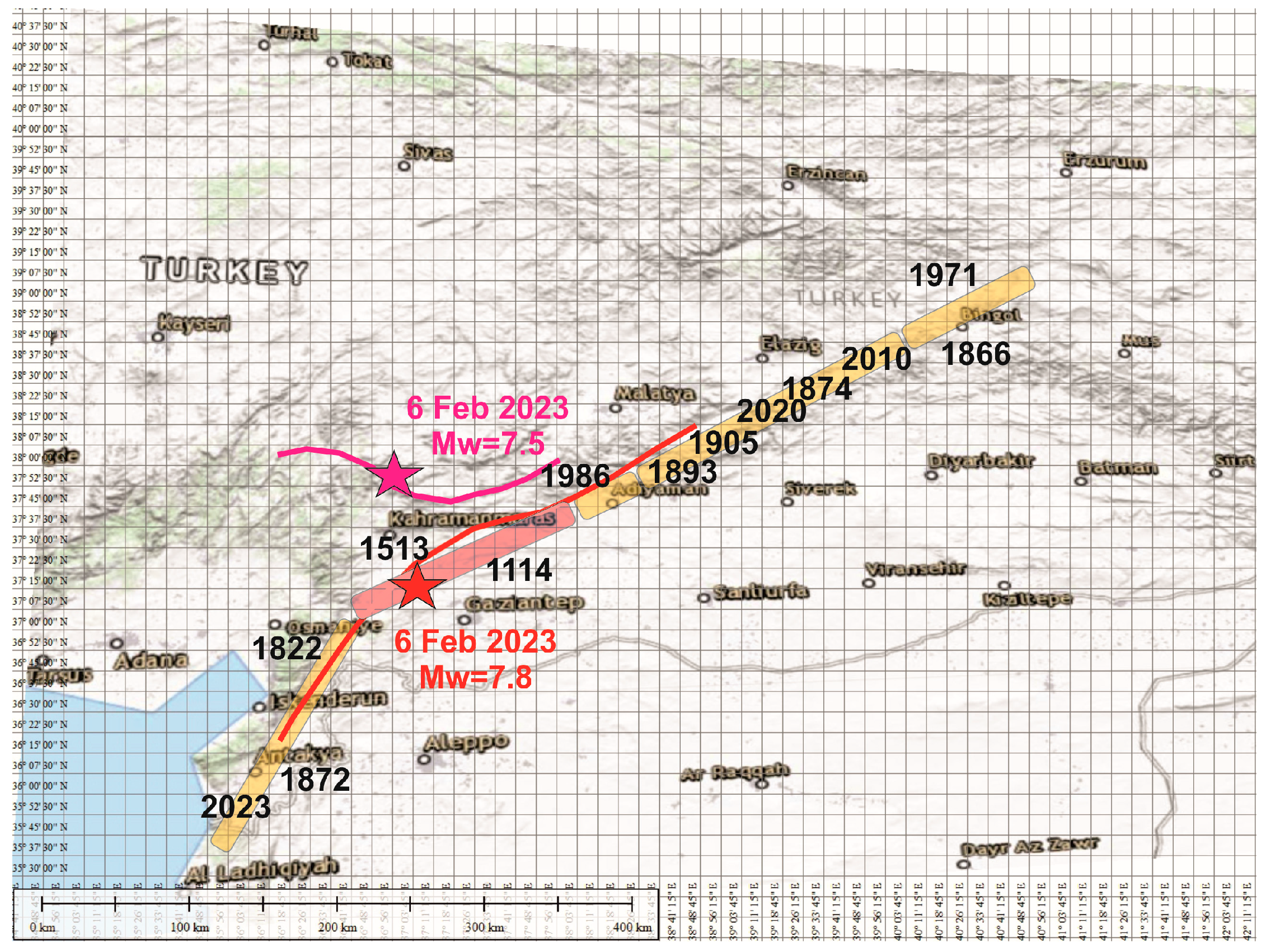
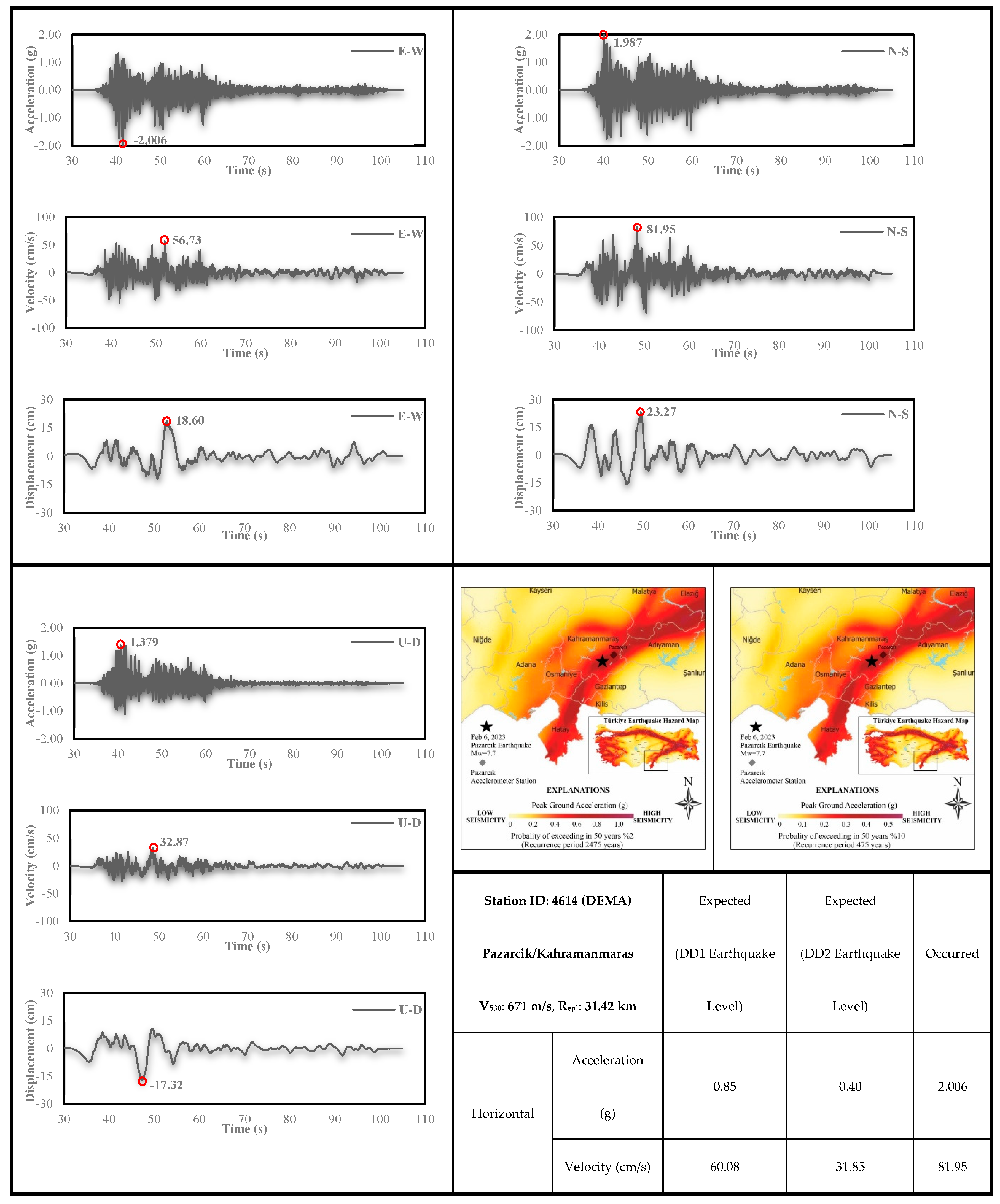


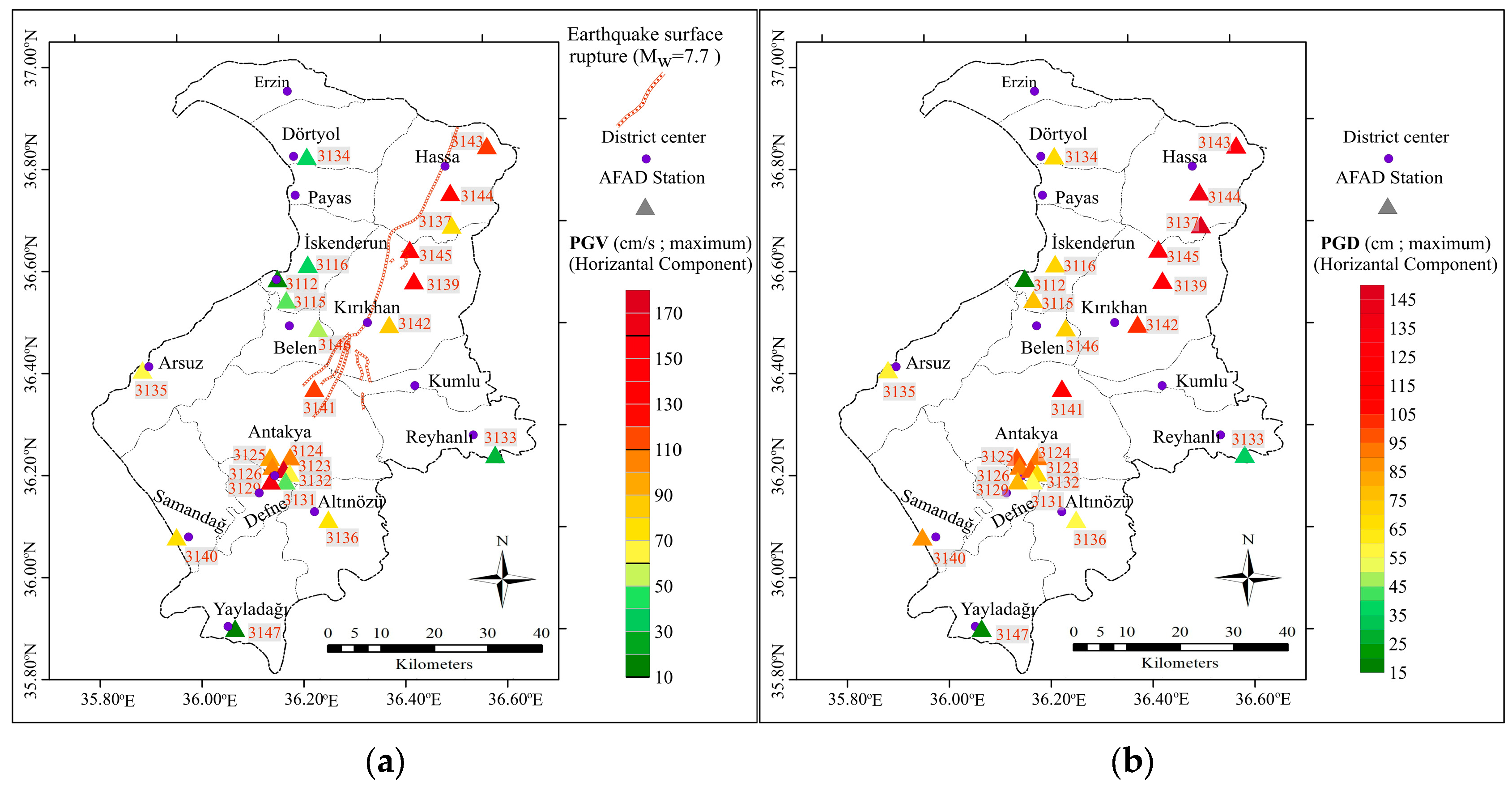
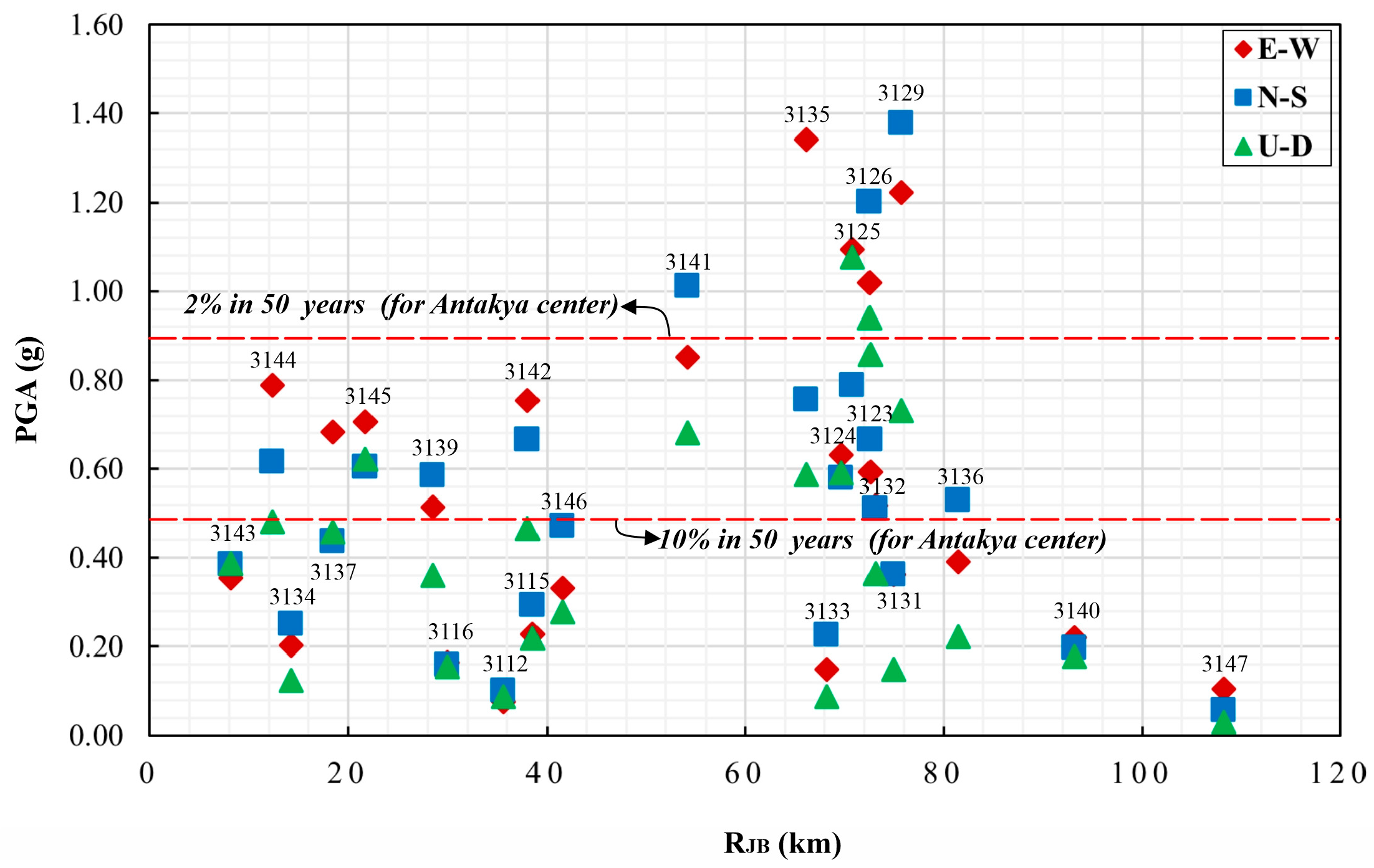

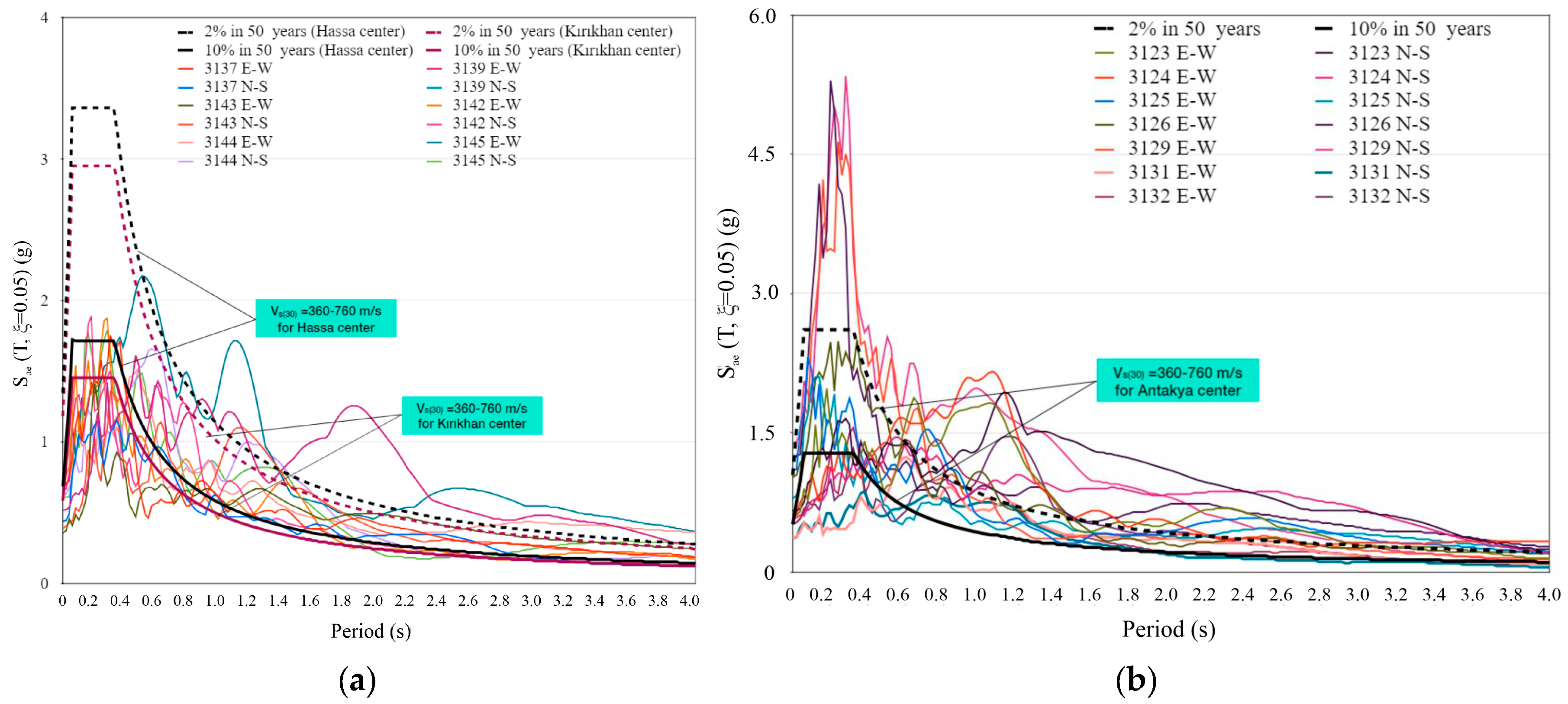
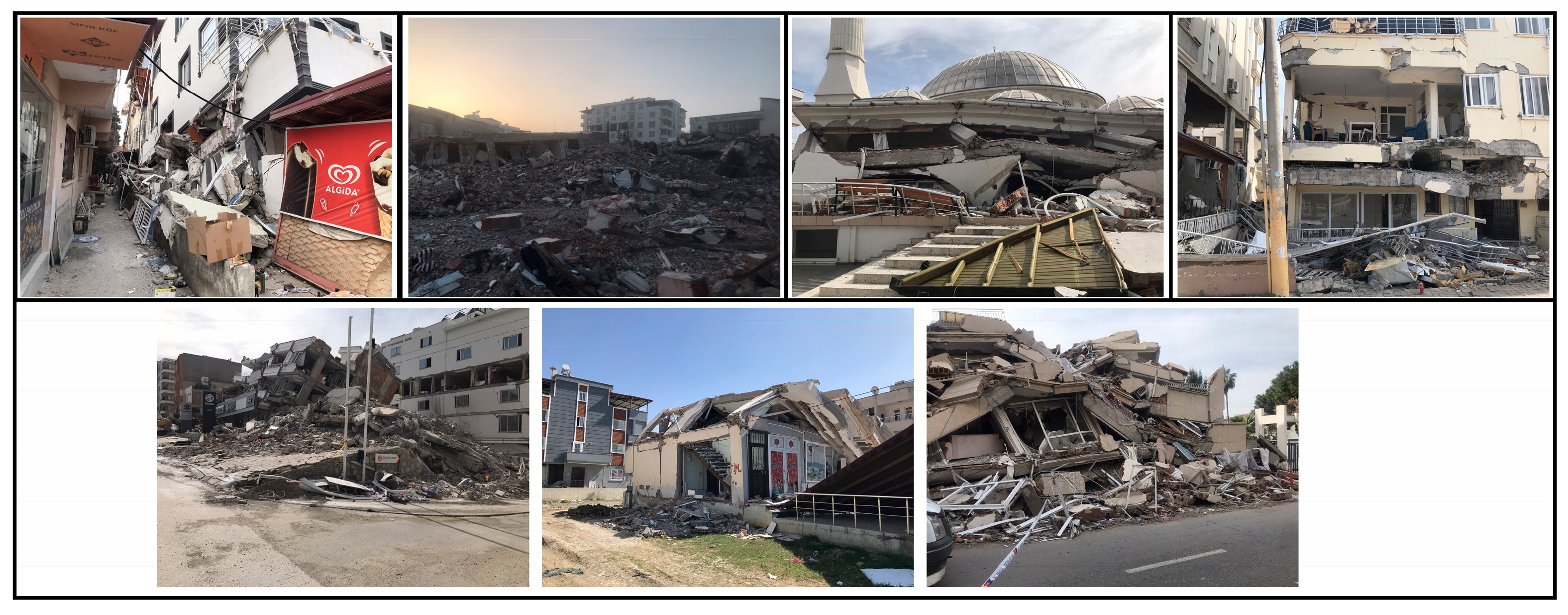


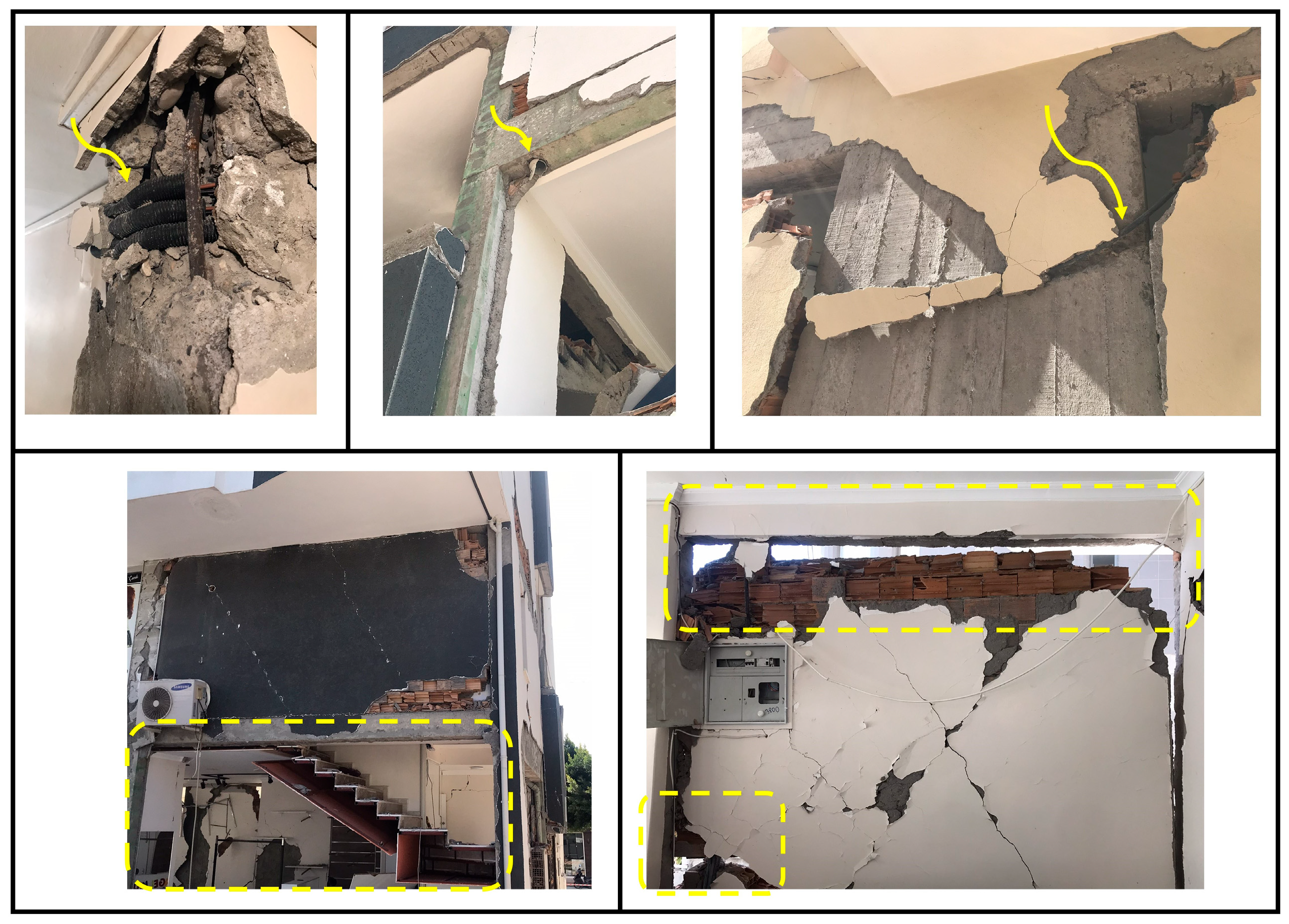

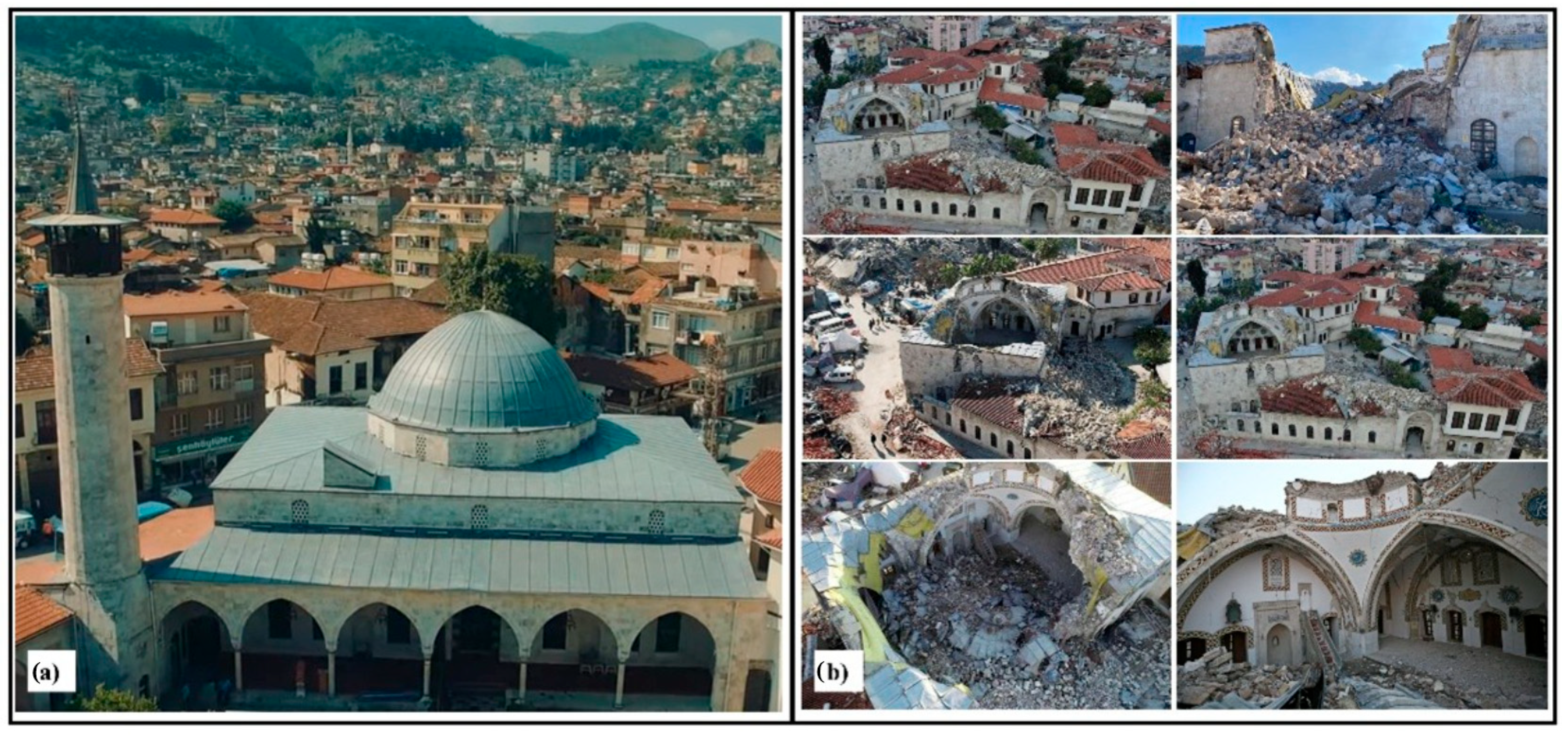


Disclaimer/Publisher’s Note: The statements, opinions and data contained in all publications are solely those of the individual author(s) and contributor(s) and not of MDPI and/or the editor(s). MDPI and/or the editor(s) disclaim responsibility for any injury to people or property resulting from any ideas, methods, instructions or products referred to in the content. |
© 2025 by the author. Licensee MDPI, Basel, Switzerland. This article is an open access article distributed under the terms and conditions of the Creative Commons Attribution (CC BY) license (https://creativecommons.org/licenses/by/4.0/).
Share and Cite
Dedeoglu, I.O. Evaluating Earthquake-Induced Damage in Hatay Following the 2023 Kahramanmaraş Earthquake Sequence: Tectonic, Geotechnical, and Structural Engineering Insights. Appl. Sci. 2025, 15, 9704. https://doi.org/10.3390/app15179704
Dedeoglu IO. Evaluating Earthquake-Induced Damage in Hatay Following the 2023 Kahramanmaraş Earthquake Sequence: Tectonic, Geotechnical, and Structural Engineering Insights. Applied Sciences. 2025; 15(17):9704. https://doi.org/10.3390/app15179704
Chicago/Turabian StyleDedeoglu, Ibrahim O. 2025. "Evaluating Earthquake-Induced Damage in Hatay Following the 2023 Kahramanmaraş Earthquake Sequence: Tectonic, Geotechnical, and Structural Engineering Insights" Applied Sciences 15, no. 17: 9704. https://doi.org/10.3390/app15179704
APA StyleDedeoglu, I. O. (2025). Evaluating Earthquake-Induced Damage in Hatay Following the 2023 Kahramanmaraş Earthquake Sequence: Tectonic, Geotechnical, and Structural Engineering Insights. Applied Sciences, 15(17), 9704. https://doi.org/10.3390/app15179704






